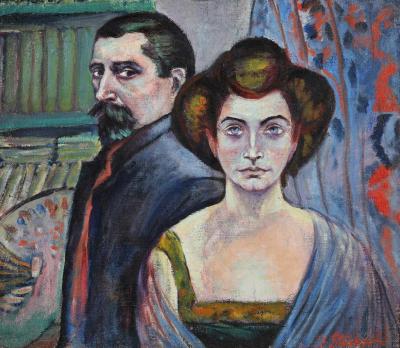Stückgold, Stanisław

Stückgold, Stanisław (Stanislaus, Stanislas), Polish painter, member of the "Munich School". Prior to 1900, he worked as an assistant in state-run chemical laboratories in Berlin and Düsseldorf. In 1907/08, he studied in Munich at the private painting school of Simon Hollósy. In 1913-21, he ran his own painting school. He was living in Munich again around 1930. *18 May 1868 in Warsaw, †9 January 1933 in Paris. He was the grandson of a respected Rabbi, and grew up in a wealthy Jewish merchant family. After finishing grammar school, he completed a degree in chemical engineering at the University of Zurich and at the Sorbonne in Paris. After his military service in the Russian army, he worked as an assistant in the state-run chemical laboratories in Berlin and Düsseldorf. Following this, he managed a chemicals factory in Warsaw, worked for railway and steamship companies in London and returned to Warsaw as the manager of a factory. In 1905/06, he took part in protests against the regime of the Czar. After being detained in Moscow and St. Petersburg, he decided to change profession. In 1907, he began studying sculpture in Warsaw at the School of Fine Arts/Szkoła Sztuk Pięknych w Warszawie but, after six months, switched to the private school of the Hungarian Simon Hollósy (1857-1918) in Munich. In 1908, during his summer of painting with Hollósy in the Hungarian artist colony Nagybánya, he met his future wife Elisabeth von Veress (1889-1961), who was born in Siebenbürgen. He moved to Paris in the same year. Stückgold studied in the atelier of the painter Henri Matisse (1869-1954), became friends with the painter Henri Rousseau (1844-1910), met Pablo Picasso (1881-1973), Otto Freundlich (1878-1843), the poet Guillaume Apollinaire (1880-1918) and the art critic André Salmon (1881-1969). During his summer in Siebenbürgen his daughter Felicitas was born paralysed and suffering from epilepsy. In 1913, the family followed the Russian art historian Trifon Trapesnikov (1882-1926) to Munich where he was campaigning for anthroposophy and working with Rudolf Steiner at the Goetheanum in Dornach. The couple hoped to get help for their daughter from Steiner’s teaching and joined the Anthroposophical Society. The painter became friends with the artists of the Blauer Reiter, particularly with Franz Marc (1880-1916) and Marianne von Werefkin (1860-1938). He opened a painting school which he ran until 1921. In April 1919, at the time of the Munich Soviet Republic, he was a member of the Munich Council for Visual Artists and co-founded the Action Committee of Revolutionary Artists; he was briefly detained. At the end of 1919, Elisabeth Stückgold travelled to Dornach with her daughter and the doctor, anthroposoph and writer Albert Steffen (1884-1963). In 1923, Stückgold returned to Paris where he again ran a painting school until 1926. Around 1930/31, it appears that he was living in Munich and socialising in the orbit of the Young Zionist Working Group. Stückgold found the basis for his art in Rousseau and Matisse. He painted landscapes, some with close-ups of plants and animals, some with an adventurous perspective, and still lifes of flowers and fruit in a two-dimensional composition, still grounded in the Art Nouveau style, with ornamental outlines and luminously bright colours influenced by Matisse. His many portraits (Martin Buber, Albert Einstein, SPD politician Oskar Cohn, his wife and daughter, 1916 Else Lasker-Schüler), to which he sometimes added features, such as flowers, fruit, books or candles, show an almost naive, two-dimensional simplicity with rough internal details. A significant part of his work is devoted to Jewish and Christian mythology, which Stückgold relates to each other, whose childishly naive composition featuring clear contours and bright colours approaches anthroposophic art appreciation. In his later work, he integrates figures in a rising soundscape and, like the anthroposophs, obviously understands art as the bridge to higher spiritual beings. His works can be found in the Von-der-Heydt-Museum in Wuppertal, in the Lenbachhaus, Munich, and in the Wiesbaden Museum. Some of his estate can be found in the Albert-Steffen-Stiftung and some in the art collection at the Goetheanum in Dornach.
Solo exhibitions: 1913/17 in Munich, Galerie Hans Goltz / 1933 Paris (posthumous), Galerie Bernheim-Jeune: Retrospective / 1958/59 Wiesbaden; Municipal Museum; Bonn, Municipal Art Collections; Munich, Municipal Gallery / 1969 Basel, Galerie Münsterberg / 2020 Kronberg im Taunus, Galerie Uwe Opper
Group exhibitions: 1909 Paris, Salon des Indépendants / 1913 Berlin, Der Sturm: Erster Deutscher Herbstsalon / 1922 Düsseldorf, Kaufhaus Tietz: First international art exibition (Polish section)
Literature: Kuno Mittenzwey: Stanislaus Stückgold-Munich, in: Deutsche Kunst und Dekoration. Illustr. Monatshefte für moderne Malerei …, vol. 40, Darmstadt 1917, page 345 f., Figures page 346 f.; Catalogue of the first international art exhibition, Düsseldorf 1922 from 28 May to 3 July 1922 at Leonhard Tietz, A.-G., Düsseldorf 1922, Section B: Foreign artists. Poland (no page); Exposition rétrospective d'œuvres de Stanislas Stückgold (1868-1933). From 14 October to 27 October 1933, Exhibition catalogue: Galerie Bernheim-Jeune, Paris 1933; Elisabeth Steffen [i.e. Elisabeth Steffen-Stückgold]: Selbstgewähltes Schicksal, vol. 1, Dornach 1961; Stanislas Stückgold 1868-1933, Exhibition catalogue: Municipal Museum, Wiesbaden, Municipal Art Collections, Bonn, Municipal Gallery, Munich, Wiesbaden 1958; Clemens Weiler: Stückgold, Wiesbaden 1962; André Salmon: Stanislas Stückgold 1868-1933, Paris 1954; Jerzy Malinowski: U źródeł polskiej awangardy. Przypomnienie Stanisława Stückgolda, in: Sztuka Europy Wschodniej, vol. 3, Warsaw 2015, page 201-207; Stanislas Stückgold 1868-1933, Exhibition catalogue: Galerie Uwe Opper, Kronberg im Taunus 2020
Online: Angela Matile: Stückgold, Stanislas, on the Forschungsstelle Kulturimpuls website, Dornach, http://biographien.kulturimpuls.org/detail.php?&id=954
Axel Feuß: Der Sturm und seine polnischen Künstler 1910-1930, in this portal, Porta Polonica (2020), page 6 f., https://www.porta-polonica.de/de/atlas-der-erinnerungsorte/der-sturm-und-seine-polnischen-kuenstler-1910-1930?page=6#body-top
(Both links were last retrieved in October 2020)
Axel Feuß, October 2020



![In the Park/W parku, Munich or Lwów 1910. Watercolour over pencil on board, 46 x 33 cm, signed bottom right: Stefanowicz [1]910, at auction (Agra Art, Warsaw 2019) In the Park/W parku, Munich or Lwów 1910. Watercolour over pencil on board, 46 x 33 cm, signed bottom right: Stefanowicz [1]910, at auction (Agra Art, Warsaw 2019)](/sites/default/files/styles/width_100_tiles/public/Stefanowicz%20Kajetan.jpg?itok=BqYT6lfQ)